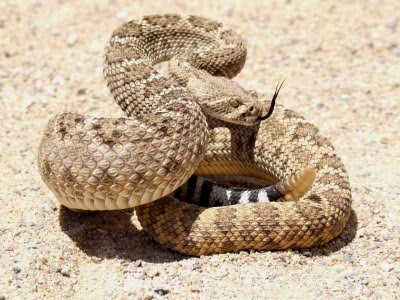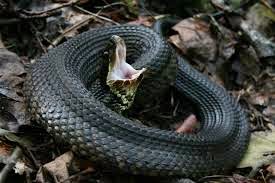The past few weeks I've seen lots of neighbors posting pictures on social media of snakes that they've found in their yard or swimming pool. Someone always asks ... "What kind of snake is that?". Well, there are lots of snakes in Texas! A better question to ask is "What kind of snake ISN'T it?". What people really want to know is if the snake is venomous!
We saw the snake above during a family outing. He was quite aggessive, puffing up and hissing at us. We still have no idea what kind of snake it is. But we knew immediately that it wasn't venomous!
I am no snake expert, but living in Texas all my life has taught me a few things about snakes.
Did you know that there are only 4 venomous snakes in Texas?
* Coral Snake
* Rattlesnake
* Cottonmouth
* Copperhead
The best lesson I learned as a child ... and one that everyone who lives in Texas needs to know ... is how to identify the venomous snakes. If you can learn to identify those, then you don't need to worry so much about all the others.
They're fairly easy to identify, too. The coral snake has its very distinct red and yellow coloring. And the other three venomous snakes are all Pit Vipers -- rattlesnake, cottonmouth, & copperhead. Pit Vipers have pits on their heads that sense heat. Because of these pits, they also have wide, triangular shaped heads that are typically bigger than their body. So whenever you see a snake, look at the head! Most of the time that will tell you real quick if it's dangerous or not.
CORAL SNAKES
"Red and yellow, kill a fellow." Remember that rhyme from childhood? That's all you need to know to stay away from coral snakes. In fact, I've told my children that if they ever see a snake with those colors, RUN. Don't stick around to see if the second part of the rhyme applies ... "red and black, friend of Jack".
Thankfully its distinctive coloring makes it easy to identify a Coral Snake. It is also the only venomous snake in Texas that is not a pit viper. Therefore it is the only venomous snake with a small head.
Coral Snakes are typically not aggressive, but its bite is very dangerous. A friend was taking Bluebonnet Pictures with his wife and sons when they saw this coral snake hiding under a rock. So always watch out when taking those annual bluebonnet pics!
RATTLESNAKES
We see rattlesnakes more than any other venomous snake around here. There are several different types of rattlesnakes in Texas. But they all make a rattling sound as a warning that danger is near. Although I've heard that they may strike without a warning if taken by surprise.
A few years ago, my daughter was riding her bicycle on the sidewalk up and down our street when she heard a rattling noise. She glanced down and there was a rattlesnake coiled up in the grass right by the sidewalk! Thankfully she was able to ride away without getting bit.
But it's those baby rattlers that you really have to watch out for since you won't hear their small rattles. Did you know that a bite from a baby rattler can be just as bad, if not worse, than a bite from an adult rattler? Baby rattlesnakes are given a full supply of venom at birth. And while an adult rattler can control the amount of venom it injects with each bite, a baby rattler is likely to inject all of its venom!
It can sometimes be difficult to identify the baby rattlers since they don't have all their rattles. One night I was walking up the sidewalk to our front door and saw two baby snakes in my path. I was startled and screamed for my husband to come kill them. In the morning we got a closer look at the snakes. Although they looked similar in their coloring, especially in the dark, you can tell upon closer inspection that one of them was a baby rattlesnake. See its wide head and thick tail with the beginnings of a rattle?
And last Fall we found this dangerous little guy crawling up the front porch. Thankfully we were coming back from a golf outing, so my husband made good use of his 7 iron.
I remember a few years ago, the local news reported on a woman who had been bitten by a baby rattlesnake. She had picked up a potted plant in the gardening department of a big box store, and it crawled out and bit her hand. There have been several other similar incidents reported over the years. Ever since hearing that story, though, I make sure to NEVER bring potted plants into the house directly from a gardening center. I always leave them outside until I've had a chance to re-pot them in my own decorative pots.
COTTONMOUTH aka WATER MOCCASIN
I've seen a few of these vicious snakes when camping near rivers and lakes. They usually don't stray far from water. Cottonmouths aka Water Mocassins are also pit vipers. You can identify them by their thick dark-colored body ... and contrasting white mouth. Thankfully I've never seen its "cottonmouth".
A cottonmouth can be quite aggressive if cornered or threatened. But it might just leave you alone if it doesn't feel the need to defend itself. So we always splash around and make lots of noise whenever we're in the water so that they'll know we're coming and (hopefully) swim away. My sister swears, though, that one swam right over her legs when she was tubing in the Frio River!
Copperhead
These pit vipers round out the deadly four in Texas. The copperhead snake obviously gets its name from its color. They also have the wide head of a pit viper. Just know, the copperhead snake is one of the most likely to bite!
Thankfully I've never seen one of these. But my cousin was bitten by one when doing yard work. He reached under some shrubs and felt a bolt of lightning shoot through his arm. Thankfully he recovered, but he was in the hospital for several days.
Baby copperhead snakes also have a distinctive yellow tail. Like the rattlesnake, baby copperheads are very dangerous! They are very active when born and will bite anything they can.
A good resource for learning more about venomous snakes can be found on the Texas Parks and Wildlife website . . . http://tpwd.texas.gov/kids/wild_things/wildlife/snakes.phtml.










.
ReplyDeleteThere are several things wrong with this article. But first you're wrong to spread misinformation about coral snakes. Stop using that rhyme and do your research. Encourage people to study about venomous snakes and all key identifiers to determine if it's venomous or nonvenomous.
ReplyDeleteThere are several things wrong with this article. But first you're wrong to spread misinformation about coral snakes. Stop using that rhyme and do your research. Encourage people to study about venomous snakes and all key identifiers to determine if it's venomous or nonvenomous.
ReplyDelete